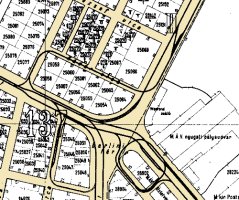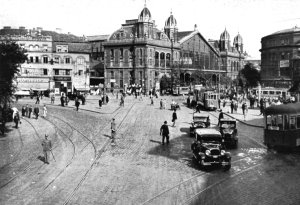budapest
other hungarian
close-up
lost rails
other countries
-
Nyugati
station and the trams around it I.
Nyugati station was Budapest's first railway station, so its place in the rail history of Hungary is secured, that's for sure! But that's not all: the place where the station stands is also connected to our tram history, too. The first horse tram line between Kálvin tér and Újpest (1866) had a stop here, from that point on we can speak of this location as an important traffic node. At first sight this might seem strange, because you would expect that a railway station is always an important traffic node, but you have to understand that this place lay in the outskirts of Pest when it was built in 1846, and so played only marginal role in the city's life. The Nagykörút (Grand Boulevard), one of the main traffic paths of the city was built out only several decades later - but the existence of the tram line and a few years later the scheming of the Grand Boulevard (1871) turned the surroundings of the railway station into one of the busiest spots of the by the then united twin city of Budapest. To celebrate the turn of events, a new station was designed and built by hungarian and french (Bureaux Eiffel) architects in 1877.
New developments lead to even more development: traffic grew and grew, and in 1887 the terminus, generator station and depot of the experimental electric tram was built in front of the new station. A new era has begun...
The first electric
tram in Budapest
BVVV lines
BKVT lines
The BSzKRt era
After
World War 2
Terminal
of the Small Boulevard lines (48, 49, 53, 47, 52)
The
middle of the square
Terminal
of the Újpest, Rákospalota and Óbuda routes (3, 12, 14, 33, 55)
Present
and future
A small remark: to make things easier, I use current (as of 2002) names for places and streets. They have been renamed many times in the last more than hundred years, so it would be quite wearing to mention all of them...
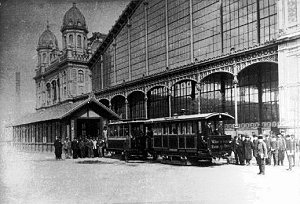
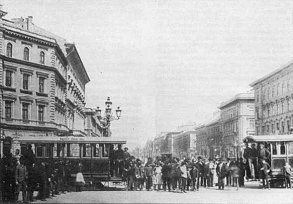
The first electric tram
of Budapest in front of Nyugati station. The small building behind the
two cars on the picture hid the generator and also served as a depot. After
the experimental phase, when the line was rebuilt to normal gauge, it was
pulled down. The other picture shows the tram line crossing Andrássy út
at Oktogon.
The first tram in Budapest with electric traction set off on the 28th of November, 1887. It was a glorious day!
Siemens & Halske designed a meter-gauge tram system with underground conduit (hiding between the two halves of one of the running rails) specially for Budapest. The line was in fact a real-life experiment founded by the company itself to promote the usage of electric trams. It was operated between Nyugati station and Király utca with three cars (two motor cars and one trailer) using 145V AC, running at 10 km/h max. Stops: Nyugati tér (tér = square), Szondi utca, Oktogon, Oktogon II, Király utca. People were first scared of the fact that the current comes from underground, but then they fell in love with the "electric railway" as they have called it back then, quickly. What's more important, the good reception convinced the City Convention that electric trams work (although they still ruled out the usage of overhead wires). A new company called BVV was set up (again by Siemens & Halske) to build the first normal-gauge (1435 mm) tram in Europe in Baross utca, between Egyetem tér and Orczy tér. They also completed the Grand Boulevard line of the company (later renamed to BVVV when bought out by investors) by 1892, this time using normal-gauge tracks. With this, the core of a tram network was laid down.
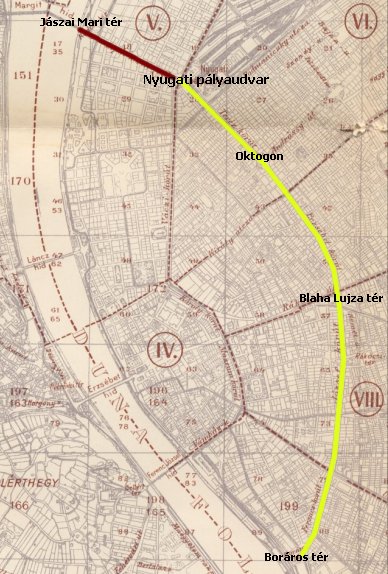
The Grand Boulevard on a
1914 map. I marked the part of the route owned by BVVV with a yellow, and
the rest, owned by BKVT with a brown line.
The success of BVV forced Budapest's traditional horse-tram company BKVT into electrifying its lines and re-think its network. A fierce battle started between the two companies turning the city into one of the tram capitals of the world!
This battle had a few disadvantages. For example, BVVV owned Grand Boulevard between Nyugati station and Boráros tér (Teréz körút - Erzsébet körút - József körút - Ferenc körút), but BKVT had a concession for the boulevard between Nyugati and Jászai Mari tér (Szent István körút), and also for Buda and the Small Boulevard (which consists of Bajcsy-Zsilinszky út - Károly körút - Múzeum körút - Vámház körút). This meant that the ring-roads of the inner city were disjointed, leading to frequent interchanges for the metropolitans during rides. What now is just a stop of tram lines 4 and 6 was a terminus for BVVV's core routes then.
BVVV routes stopping at Nyugati in 1901 (route numbers were not yet introduced):
Nyugati station - via Grand
Boulevard - Boráros-tér (Petőfi híd (híd = bridge)
didn't exist yet)
Nyugati station - via Grand
Boulevard - via Baross utca - Egyetem tér
Nyugati station - via Grand
Boulevard - via Mester utca - Ferencváros station
BVV routes stopping at Nyugati in 1918:
6: Nyugati station - via Grand
Boulevard - Boráros tér
46: Nyugati station - via Terézváros - via Erzsébetváros - Keleti station
The smaller number of routes of course
does not mean that Nyugati tér has lost its importance - it's just
that the network was redesigned with core routes like line 6, and conveyor
lines that carried the passengers to the core routes.
Because BKVT has started earlier with the development of a (horse-tram) network, they had concessions for most of the big streets of the inner city. Their lines at Nyugati could be divided into two groups: one is the axis of the first horse tram line coming from the heart of the city on Bajcsy-Zsilinszky út and going to the outskirts through Váci út, the other is the Small Boulevard routes (the Small Boulevard consists of Bajcsy-Zsilinszky út - Károly körút - Múzeum körút - Vámház körút). This second route was used by many circular services coming and going from and to Buda (the other side of the river Danube) in both directions.
BKVT routes stopping at Nyugati in 1910:
7: Óbuda - via Margit híd (bridge) - Nyugati station - via Bajcsy-Zsilinszky út - via Szabadság
híd - via the Danube enbankments - Óbuda
9: same as 9 in the opposite direction
39: Hűvösvölgy - via Városmajor - via Margit híd - Nyugati station - via Bajcsy-Zsilinszky
út - Deák tér - via Szabadság híd - via the Buda inner ring - via Városmajor - Hűvösvölgy
41: same as 39 in the opposite direction
43: Zugliget - via Városmajor - via the Danube enbankments - via Szabadság
híd - Deák tér - via Bajcsy-Zsilinszky út - Nyugati station - via Margit híd - via Városmajor - Zugliget
45: same as 43 in the opposite direction

BKVT tramcar in the middle
of the square. As you can see, there are no overhead wires - the car uses
underground conduit.
As you can see, BKVT and BVVV lines didn't overlap. When they wanted to reach the same spot, they built out their own route there, and this made the whole network redundant. As for the square in front and around the railway station, they used it in a strange way: although the tracks of the two companies were physically connected, they didn't share them. BVVV had its terminus right in front of the station, while BKVT had through and stub tracks in the axis of Bajcsy-Zsilinszky út and Váci út. As the years passed by, traffic demanded dramatic expansion of the number of passengers to be carried. This was the era when the companies introduced trailers and unidirectional trains, a move demanding 180-degrees turning possibilities at the terminals. The only solution was to built turning loops in the streets around the square. In 1911 BVVV built out a loop at where now the empty space opposite the station is - until 1979 there was a building here, which was circled by the tracks back then. Then, in 1914 BKVT set up a loop for its routes using Kádár utca and Visegrádi utca (but they haven't started to use it).
After losing World War 1 and two consecutive revolutions (!), Hungary was in a very bad shape, and this had an impact on the public transportation of Budapest, too. After the second uprising was foiled, the owners of BKVT and BVVV refused to take responsibility for the operation of the joint urban transportation company BEVV, which was formed out of their original firms back in 1918. In 1919 traffic on 23 tram routes was paused, and passengers of the remaining 40 (!) have also experienced problems: train succession was incalculable, cars and tracks were in a very bad shape. It was a big mess - deep in the post-war depression, just like the rest of the country!
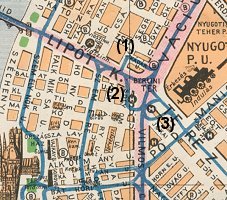
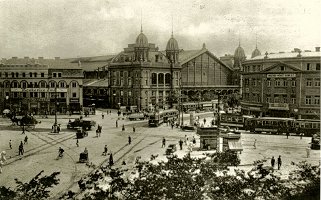
As you can see on this map
from 1928, there were three turning loops around Nyugati. To the right:
the same in real life.
Things finally started to look better after a new public transportation company was formed by the city - its name was BSzKRt. In reality this was the merger of BKVT, BVVV and the acquisition of the majority of shares in several small transportation companies like FJFVV (the operator of the Milleneum subway line), BURV, BVKV and BLVV. The new company had a lot to do (e.g. standardizing equipments, repairing rolling stock, replacing conduit with catenary on all of the network, etc). One of their most important duties was rationalizing the network. Company concession boundaries were ceased, parallel services were abandoned, disjointed branches were connected. However, the importance of Nyugati tér was still big enough, so in 1924 a new turning loop was opened using newly built tracks in Stollár Béla utca and Bihari János utca. This could be also used as a roundabout so that routes coming from Bajcsy-Zsilinszky út could evade the possible (tram) traffic jams at the busy Nyugati tér. Also, they took the Kádár utca - Visegrádi utca loop into use.
BSzKRt routes at Nyugati station
in 1928:
3: Újpest - via Váci út - Nyugati station (using loop number 1)
4: Szent János kórház - via Széna
tér (Moszkva tér did not exist yet) - via Margit körút - via Bem József utca - Bem József tér - via Frankel Leó
utca - via Margit híd - via Szent István körút - Nyugati station - via Grand Boulevard - Boráros tér
5: Népliget - via Elnök utca - via Üllői út - Kálvin tér - Deák Ferenc tér - via Bajcsy-Zsilinszky
út - Nyugati station - via Margit híd - Frankel Leó
utca - via Lajos utca - Óbuda, Fő tér
6: Boráros tér - via Grand Boulevard - Nyugati station (using loop number 3)
7: Óbuda, Vörösvári út - via Lajos
utca - via Frankel Leó utca - via Margit híd - Nyugati station - via Grand Boulevard - Boráros tér
11: Közvágóhíd - Boráros tér - via Lónyai utca - Kálvin tér - Deák tér - via Bajcsy-Zsilinszky
út - Nyugati station - via Váci út - Újpest
15: Városliget - via Damjanich
utca - via Rottenbiller utca - Keleti station - via Rákóczi
út - Deák tér - via Bajcsy Zsilinszky út - Nyugati station - via Margit híd - Széna tér
33: Zoo - via Hermina út - via Thököly út - Keleti station - via Rákóczi út - Deák tér - via Bajcsy Zsilinszky út - Nyugati station
(probably passing through loop number 2) - via Margit híd - Széna
tér
46: Keleti station - via Bethlen
Gábor utca - via Bajza utca - via Városligeti fasor - Lövölde
tér - via Felsőerdősor utca - Kodály kőrönd - via Szinyei
Merse utca - via Podmaniczky utca - Nyugati station (with
a stub terminus at the corner of Podmaniczky utca and the Great
Boulevard)
48: Kelenföld station - via Bartók
Béla út - Szent Gellért tér - via Szabadság híd - Fővám
tér - Deák tér - Erzsébet tér - via Október 6 utca - Szabadság tér - via Hold utca - via Szemere utca - via Szent István körút - Nyugati station
49: Kelenföld station - via Bartók
Béla út - Szent Gellért tér - via Szabadság híd - Fővám
tér - Deák tér - via Bajcsy Zsilinszky út - Nyugati station
55: Rákospalota - via Pozsony
utca - via Szilágyi utca - via Görgey utca - via István
út - via Árpád út - via Váci út - Nyugati station
(using loop number 1)
73: Óbuda, Vörösvári út - via Bécsi
út - via Frankel Leó utca - via Margit híd - Nyugati station - via Grand Boulevard - Boráros tér
77: Szépilona - Széna tér - via Margit híd - Nyugati station (using loop number 2)
Routes operated by BURV:
BURV "A": Rákospalota - via Fő út - via Árpád út - via István út - via Pozsonyi
utca - via Béke utca - via Lehel utca - Lehel tér - via Váci út - Nyugati station (using loop number 1)
BURV "B": Megyer - via Irányi Dániel utca - via Megyeri út - via Vasvári
Pál utca - via Baross utca - via Károlyi utca - Szent
István tér - via István út - via Pozsonyi utca -
via Béke utca - via Lehel utca - Lehel tér - via Váci
út - Nyugati station (using loop number 1)
BURV "C": Istvántelek - via Arad
utca - via Nagyvárad utca - via Temesvár utca - via Rózsa
utca - via Ősz utca - via Lebstück Mária utca - via Pozsonyi
utca - via Béke utca - via Lehel utca - Lehel tér - via Váci út - Nyugati station (using loop number 1)
BURV "J": Újpest, Árpád út - via István
út - via Pozsonyi utca - via Béke utca - via Lehel
utca - Lehel tér - via Váci út - Nyugati station
(using loop number 1)
I'm pretty sure that this is an undigestable heap of street names for most of you, but I can assure you that this was tram heaven - most of these lines are long gone now: closed, abandoned or replaced by subway! You can try to find these places on this map, and if you know today's Budapest a bit, you'll be amazed to find trams where you would least expect them!
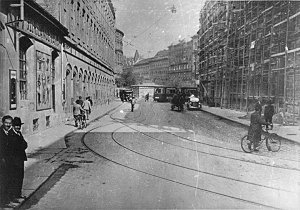
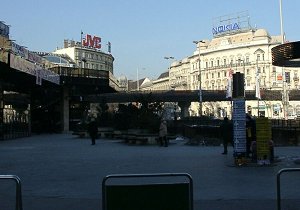
To the left: Jókai utca
(part of loop number 3 on the map we just saw) with the traverse of the
two-track turning loop. To the right: the same location in 2002.
In the 1930's BSzKRt reorganized its routes and tariff system once more, cutting the Grand Boulevard into two sections again! At the same time they expanded the turning loop for the Grand Boulevard services with a second track. The two tracks traversed over each other so that trams would leave the loop at the right side. To make room for the new boarding platform, one of the straight-through tracks between Bajcsy-Zsilinszky út and Váci út was removed, forcing trams going this way to take a little detour through Visegrádi utca and Kádár utca.
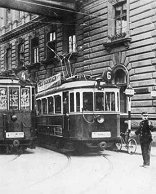

To the left: two trams turning
to Jókai utca after arriving from the Grand Boulevard. To the right: the
south-east corner of the square with the end of Jókai utca
This was part of an attempt to reduce the services going through the square: from the 18 lines in 1910 only 8 has left. Before we go on, let's see two images from the twenties and thirties! To the left: two trams (a 1000er and a 2800-series car) in Jókai utca. To the right: the tram coming towards us and the lower right corner of the picture is leaving the Jókai utca loop for Óbuda, while the other (with two trailers) is heading back for the Grand Boulevard.
This map shows the square (called Berlini tér - Berlin square then) in 1937. You can see the three turning loops, some passing loops and the lack of straight tracks between Váci út and Bajcsy-Zsilinszky út quite clearly. On the picture next to the map you can see the zillions of tracks in real life.
Current photos: Varga Ákos Endre, unless stated differently
Back to the top Back to the main page
